The beauty of the dress 汉服英文ppt
- 格式:pptx
- 大小:11.21 MB
- 文档页数:20
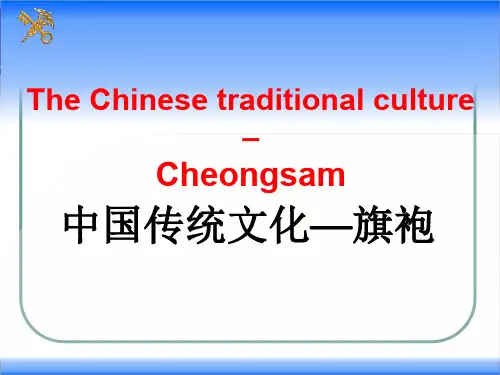
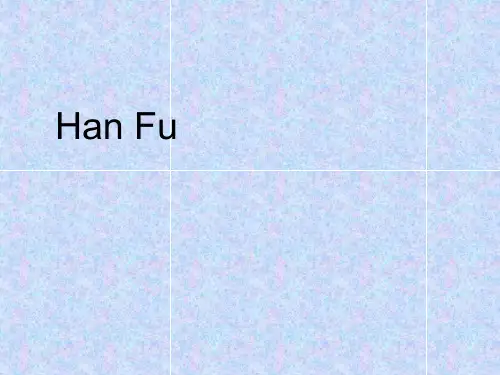
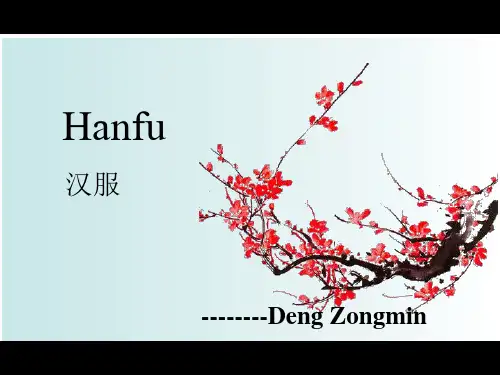
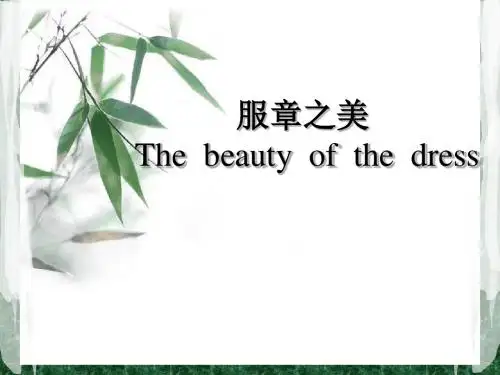

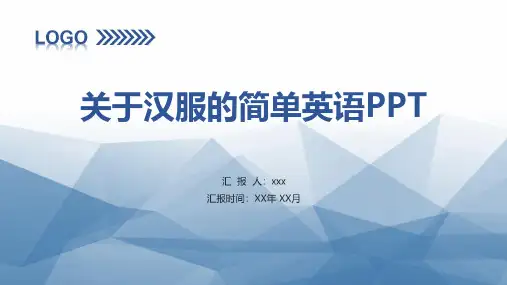
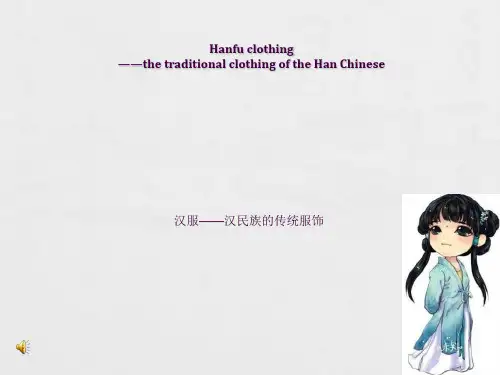
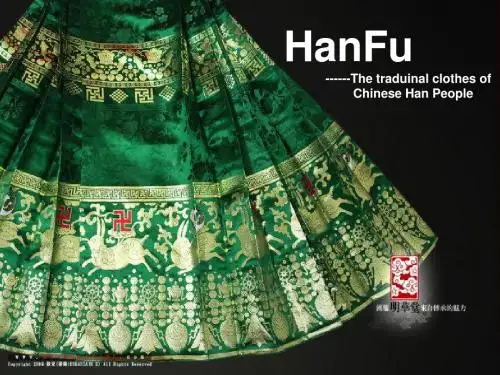
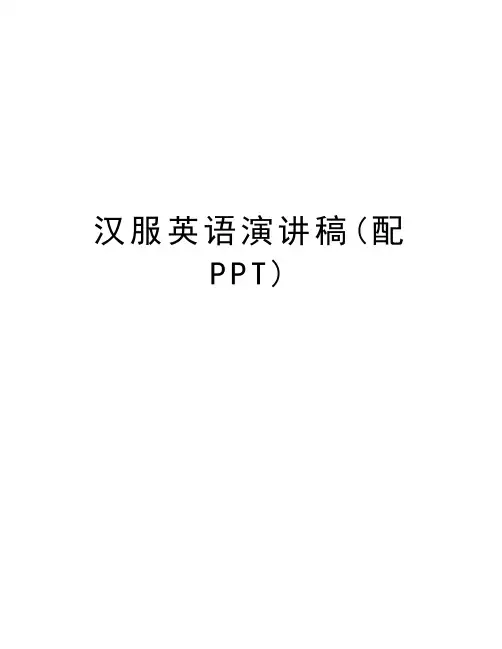
汉服英语演讲稿(配P P T)Good morning everyone, I’m glad to stand here and give you a speech.1. As we all know, China has 56 nationalities and each nation has its own specific traditional costumes, like Korean,Tibetan,Hui,Mongolian and Manchu. Han nationality has the largest number of the Chinese people. So what is Han People’s traditional clothes?”2. Cheongsam? Or the nowadays T-shirt?No! We have our clothes.3. It’s called Hanfu . It's the traditional costume that has been worn by Han people .4. However, it’s sad to know that a lot of people don’t know Hanfu nowadays. Whena person who is dressed in Hanfu walked down the street , some people may think it is a kimono or a Hanbok. What’s more, there were even some people who asked the person to take off the clothes and burned it with fire. How ridiculous!5. Now let me introduce our Han people’s traditional clothes to all of you. Hanfu, means "Clothing of the Han people "in Chinese. It refers to the pre-17th century traditional clothing of the Han Chinese .It has the history of more than 3000 years. And it influenced Japanese kimono and Kroean hanbok.6. Hanfu is wrapped around the body with the left side over the right, which just looks like the letter ‘y’ when seen from the front. But there are also other kinds of collars.Hanfu(汉服)has many patterns. Ruqun(襦裙)is worn by women.7. When its collar likes the letter “y”,we can called it Jiaolingruqun(交领襦裙).8. If its collar likes the number“11”,we can called it duijinruqun(对襟襦裙).9. When it is classified by its height of the skirt,we can called it qiyaoruqun(齐腰襦裙)——Which waistband is on the waist.10. Or qixiongruqun(齐胸襦裙)——Which waistband is above the chest .11. There is another kind of Hannfu. When its edge is bent ,we can call it Quju(曲裾)12. As we can see, Hanfu has many features , like curve, graceful ,elegant, generous and unfettered.13. According to the Han people’s tradition,there are many important days. One the day you are 15(for girls) or 20(for boys).We will hold a ceremony to celebrate to be an adult. And remember the responsibility.14. Nowadays, many people love our traditional culture , so they wear Hafu, found clubs, hold activities and so on. This summer, Chengdu’s Cherry Blossom Festival, a little girl who dressed in Hanfu left a deep impression on visitors . Here are some pictures of her. She is really cute, isn’t she ?15. Chinese civilization, also called "Hua-Xia" . "Hua" means the beauty of the dress anddecoration which is Hanfu clothing; "Xia"("Shia") is the grandeur of rites and social c onduct. And Hanfu reflects the philosophy of Chinese people: Living elegantly and poetically.I like Hanfu, so today I’m not just telling you a type of clothing called Hanfu. I hope more and more people focus on our traditional culture and don’t let such precious and beautiful things disappeared. OK , that’s all what I want to say, thank you.。
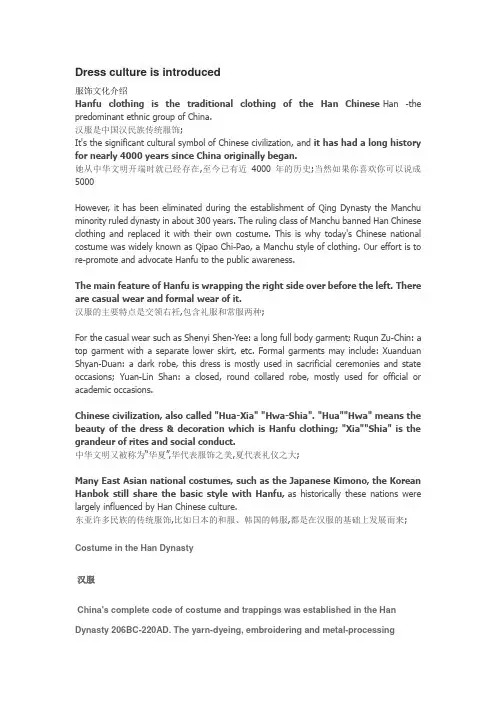
Dress culture is introduced服饰文化介绍Hanfu clothing is the traditional clothing of the Han Chinese Han -the predominant ethnic group of China.汉服是中国汉民族传统服饰;It's the significant cultural symbol of Chinese civilization, and it has had a long history for nearly 4000 years since China originally began.她从中华文明开端时就已经存在,至今已有近4000年的历史;当然如果你喜欢你可以说成5000However, it has been eliminated during the establishment of Qing Dynasty the Manchu minority ruled dynasty in about 300 years. The ruling class of Manchu banned Han Chinese clothing and replaced it with their own costume. This is why today's Chinese national costume was widely known as Qipao Chi-Pao, a Manchu style of clothing. Our effort is to re-promote and advocate Hanfu to the public awareness.The main feature of Hanfu is wrapping the right side over before the left.There are casual wear and formal wear of it.汉服的主要特点是交领右衽,包含礼服和常服两种;For the casual wear such as Shenyi Shen-Yee: a long full body garment; Ruqun Zu-Chin: a top garment with a separate lower skirt, etc. Formal garments may include: Xuanduan Shyan-Duan: a dark robe, this dress is mostly used in sacrificial ceremonies and state occasions; Yuan-Lin Shan: a closed, round collared robe, mostly used for official or academic occasions.Chinese civilization, also called "Hua-Xia" "Hwa-Shia". "Hua""Hwa" means the beauty of the dress & decoration which is Hanfu clothing; "Xia""Shia" is the grandeur of rites and social conduct.中华文明又被称为“华夏”,华代表服饰之美,夏代表礼仪之大;Many East Asian national costumes, such as the Japanese Kimono, the Korean Hanbok still share the basic style with Hanfu, as historically these nations were largely influenced by Han Chinese culture.东亚许多民族的传统服饰,比如日本的和服、韩国的韩服,都是在汉服的基础上发展而来; Costume in the Han Dynasty汉服China's complete code of costume and trappings was established in the Han Dynasty 206BC-220AD. The yarn-dyeing, embroidering and metal-processingtechnologies developed rapidly in the period, s中国完整的服装服饰制度在汉朝确立的;汉代染织工艺、剌绣工艺和金属工艺发展较快,推动了服装装饰的变化;purring changes in costume and adornments.汉时劳动女子总是上穿短襦,下穿长裙,膝上装饰长长垂下的腰带;劳动男子常服是上身穿襦,下身穿犊鼻裤,并在衣外围罩布裙;这种装束不分工奴、农奴、商贾、士人都一样;The costume code of the Western Han Dynasty 206BC-8AD followed the one established in the Qin Dynasty 221-206 BC. In the Eastern Han Dynasty, people in black had to wear purple silk adornments to match their clothes. People usually wore costume with a long hat at grand ceremonies offering sacrifices to gods or ancestors. The dress of the queen in these ceremonies consisted of dark-purple frock and black trousers. The silk dress of the queen consisted of cyan frock and buff trousers.西汉建立时基本上沿用秦朝的服制;东汉时期穿黑色衣服必配紫色丝织的装饰物;祭祀大典上通用的是“长冠服”;皇后的祭祀服是:上衣用绀色,下裳用皂色;皇后的蚕服,上衣用青色,下裳用缥色浅黄色;汉文帝当政时比较俭朴,自己穿黑色丝织衣、皮鞋;一般官员要穿禅衣,又名“祗服”;The Western Han Dynasty implemented the Shenyi long coat system, which featured a cicada-shaped hat, red clothes and "田"-shaped collar. In addition, people of that time wore jade articles and red shoes. The frock and skirt were sewn together in the Shenyi system. Underpants for memorial ceremonies were decorated with black brims, and those for court dress in feudal China were decorated with red brims. All the garments were collectively called as Chanyi unlined garment.在西汉时期二百年之中,服饰实行“深衣制”,它的特点是象蝉一样的头冠帽子、红色的衣服、象田字状的领子、戴玉、红色的鞋;深衣形制是上衣下裳相连接缝在一起,做祭服的中衣,要缘黑色边,作为朝服的中衣,需缘红色边,当时男女服用极为普遍;服饰总称“禅衣”;禅衣是单层的外衣;禅衣里面有中衣、深衣,其形与禅衣无大区别,只是袖形有变化,都属于单层布帛衣裳;官员在上朝时都要穿黑色禅衣;Costumes in the Han Dynasty fell into two categories according to Yijin one or two pieces making up the front of a Chinese jacket or grown. There were two types of garments: the curving-front unlined garment with buttons deviously down from the collar to the axilla; the straight-front unlined garment with buttons were straightly down from the collar to the lower part. Curving-front garment originated from the Shenyi long coat prevalent in the Warring States Period, and was still in use in the Han Dynasty. But few people wore the Shenyi garments during the Eastern Han Dynasty.汉衣款式以衣襟分类,可以划分两种:一为“曲裾禅衣”,即开襟是从领曲斜至腋下;一为直裾禅衣,是开襟从领向下垂直,此种禅衣又称“”;曲裾,即为战国时期流行的深衣;汉代仍然沿用,到东汉,男子穿深衣的已经不多了,一般为直裾衣,但并不能作为正式礼服;这种服式既长又宽,从款式上官民服用基本没有差别,但从原料和颜色上,却可明显显示等级的不同;There were specific stipulations on colors of court garments in the Han Dynasty. Officers must wear garments according to the five time periods, i.e. cyan garments in the spring, red in the first two months of the summer, yellow in the last month of the summer, white in the autumn and black in the winter.汉代朝服的服色有具体规定,一年四季按五时着服,即春季用青色;夏季用红色;季夏用黄色;秋季用白色;冬季用黑色;Costumes of the Han Dynasty had 7 features: 汉代着衣有七个特点:1. Wearers must expose underpants' collar form , as the collar was big and curving;1、穿外衣时,由于领大而且弯曲,穿衣时必需暴露中衣的领型;2. Clothes must use white cloth as lining;2、穿衣必用白色面料做里;3. The width of sleeve was 0.4 meters;3、袖宽为一尺二寸;4. The blouse had no sleeve;4、衫无袖;5. Wearers of fur clothes should have the fur facing outside;5、穿皮毛服装时裘毛朝外;6. Waistband was very exquisite. Belt hook was made of gold in various lively and interesting animal figures;6、腰带极为考究,所用带钩以金制成各种兽形,如螳螂形或琵琶形;形象十分生动有趣;一般长度在一寸半至六寸之间,是衣裳中间显要的装饰物;汉带钩从形、色和工艺上都达到了极高的水平,较比西周和战国时期,在设计和制作方面都要精美得多;因此颇受男人们的喜爱,佩戴者很多;7. The male kept the habitude of wearing walking sabres without blades for decoration only.7、男子保持佩刀习俗,但所佩之刀有形无刃,因此失去了实际价值,主要是显示仪容;Female laborers of the Han Dynasty always wore short jackets and long skirts, and their knees were always decorated with long hanging waistbands. dressing style at that time.汉代祭服延用“大制度”,遵从古礼穿冕服佩绶、佩玉;皇帝、公卿、诸侯均用大,只是在所系玉石的串珠或丝绳的质地上加以区别;皇太后、太后、公卿夫人等的祭服谒庙服、亲蚕服、朝见服和婚礼服的形式都采用深衣制;Male laborers often wore jackets and calf-nose trousers with aprons around the garments. Farmers, workers, businessmen and scholars were all in the same汉时劳动女子总是上穿短襦,下穿长裙,膝上装饰长长垂下的腰带;劳动男子常服是上身穿襦,下身穿犊鼻裤,并在衣外围罩布裙;这种装束不分工奴、农奴、商贾、士人都一样;Clothing is the spirit of the age, ethnic 服饰是时代精神,民族的反映。
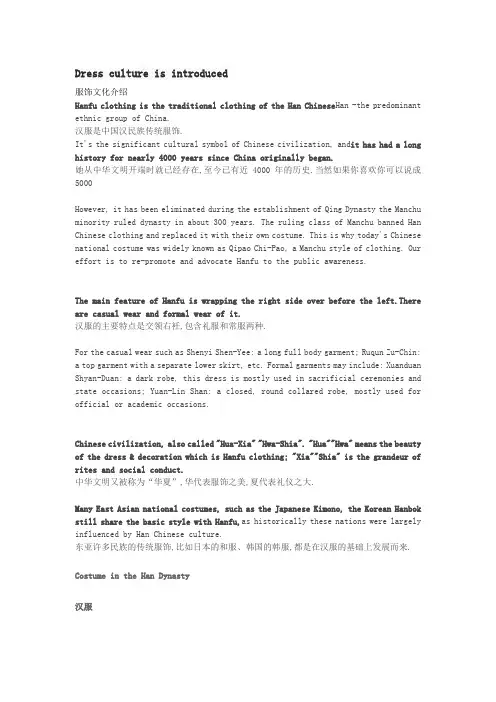
Dress culture is introduced服饰文化介绍Hanfu clothing is the traditional clothing of the Han Chinese Han -the predominant ethnic group of China.汉服是中国汉民族传统服饰.It's the significant cultural symbol of Chinese civilization, and it has had a long history for nearly 4000 years since China originally began.她从中华文明开端时就已经存在,至今已有近4000年的历史.当然如果你喜欢你可以说成5000However, it has been eliminated during the establishment of Qing Dynasty the Manchu minority ruled dynasty in about 300 years. The ruling class of Manchu banned Han Chinese clothing and replaced it with their own costume. This is why today's Chinese national costume was widely known as Qipao Chi-Pao, a Manchu style of clothing. Our effort is to re-promote and advocate Hanfu to the public awareness.The main feature of Hanfu is wrapping the right side over before the left.There are casual wear and formal wear of it.汉服的主要特点是交领右衽,包含礼服和常服两种.For the casual wear such as Shenyi Shen-Yee: a long full body garment; Ruqun Zu-Chin: a top garment with a separate lower skirt, etc. Formal garments may include: Xuanduan Shyan-Duan: a dark robe, this dress is mostly used in sacrificial ceremonies and state occasions; Yuan-Lin Shan: a closed, round collared robe, mostly used for official or academic occasions.Chinese civilization, also called "Hua-Xia" "Hwa-Shia". "Hua""Hwa" means the beauty of the dress & decoration which is Hanfu clothing; "Xia""Shia" is the grandeur of rites and social conduct.中华文明又被称为“华夏”,华代表服饰之美,夏代表礼仪之大.Many East Asian national costumes, such as the Japanese Kimono, the Korean Hanbok still share the basic style with Hanfu,as historically these nations were largely influenced by Han Chinese culture.东亚许多民族的传统服饰,比如日本的和服、韩国的韩服,都是在汉服的基础上发展而来. Costume in the Han Dynasty汉服China's complete code of costume and trappings was established in the Han Dynasty 206BC-220AD. The yarn-dyeing, embroidering and metal-processing technologies developed rapidly in the period, s中国完整的服装服饰制度在汉朝确立的.汉代染织工艺、剌绣工艺和金属工艺发展较快,推动了服装装饰的变化.purring changes in costume and adornments.汉时劳动女子总是上穿短襦,下穿长裙,膝上装饰长长垂下的腰带.劳动男子常服是上身穿襦,下身穿犊鼻裤,并在衣外围罩布裙;这种装束不分工奴、农奴、商贾、士人都一样.The costume code of the Western Han Dynasty 206BC-8AD followed the one established in the Qin Dynasty 221-206 BC. In the Eastern Han Dynasty, people in black had to wear purple silk adornments to match their clothes. People usually wore costume with a long hat at grand ceremonies offering sacrifices to gods or ancestors. The dress of the queen in these ceremonies consisted of dark-purple frock and black trousers. The silk dress of the queen consisted of cyan frock and buff trousers.西汉建立时基本上沿用秦朝的服制.东汉时期穿黑色衣服必配紫色丝织的装饰物.祭祀大典上通用的是“长冠服”.皇后的祭祀服是:上衣用绀色,下裳用皂色.皇后的蚕服,上衣用青色,下裳用缥色浅黄色.汉文帝当政时比较俭朴,自己穿黑色丝织衣、皮鞋.一般官员要穿禅衣,又名“祗服”.The Western Han Dynasty implemented the Shenyi long coat system, which featured a cicada-shaped hat, red clothes and "田"-shaped collar. In addition, people of that time wore jade articles and red shoes. The frock and skirt were sewn together in the Shenyi system. Underpants for memorial ceremonies were decorated with black brims, and those for court dress in feudal China were decorated with red brims. All the garments were collectively called as Chanyi unlined garment.在西汉时期二百年之中,服饰实行“深衣制”,它的特点是象蝉一样的头冠帽子、红色的衣服、象田字状的领子、戴玉、红色的鞋.深衣形制是上衣下裳相连接缝在一起,做祭服的中衣,要缘黑色边,作为朝服的中衣,需缘红色边,当时男女服用极为普遍.服饰总称“禅衣”.禅衣是单层的外衣.禅衣里面有中衣、深衣,其形与禅衣无大区别,只是袖形有变化,都属于单层布帛衣裳.官员在上朝时都要穿黑色禅衣.Costumes in the Han Dynasty fell into two categories according to Yijin one or two pieces making up the front of a Chinese jacket or grown. There were two types of garments: the curving-front unlined garment with buttons deviously down from the collar to the axilla; the straight-front unlined garment with buttons were straightly down from the collar to the lower part. Curving-front garment originated from the Shenyi long coat prevalent in the Warring States Period, and was still in use in the Han Dynasty. But few people wore the Shenyi garments during the Eastern Han Dynasty.汉衣款式以衣襟分类,可以划分两种:一为“曲裾禅衣”,即开襟是从领曲斜至腋下;一为直裾禅衣,是开襟从领向下垂直,此种禅衣又称“”.曲裾,即为战国时期流行的深衣.汉代仍然沿用,到东汉,男子穿深衣的已经不多了,一般为直裾衣,但并不能作为正式礼服.这种服式既长又宽,从款式上官民服用基本没有差别,但从原料和颜色上,却可明显显示等级的不同.There were specific stipulations on colors of court garments in the Han Dynasty. Officers must wear garments according to the five time periods, . cyan garments in the spring, red in the first two months of the summer, yellow in the last month of the summer, white in the autumn and black in the winter.汉代朝服的服色有具体规定,一年四季按五时着服,即春季用青色;夏季用红色;季夏用黄色;秋季用白色;冬季用黑色.Costumes of the Han Dynasty had 7 features: 汉代着衣有七个特点:1. Wearers must expose underpants' collar form , as the collar was big and curving;1、穿外衣时,由于领大而且弯曲,穿衣时必需暴露中衣的领型;2. Clothes must use white cloth as lining;2、穿衣必用白色面料做里;3. The width of sleeve was meters;3、袖宽为一尺二寸;4. The blouse had no sleeve;4、衫无袖;5. Wearers of fur clothes should have the fur facing outside;5、穿皮毛服装时裘毛朝外;6. Waistband was very exquisite. Belt hook was made of gold in various lively and interesting animal figures;6、腰带极为考究,所用带钩以金制成各种兽形,如螳螂形或琵琶形.形象十分生动有趣.一般长度在一寸半至六寸之间,是衣裳中间显要的装饰物.汉带钩从形、色和工艺上都达到了极高的水平,较比西周和战国时期,在设计和制作方面都要精美得多.因此颇受男人们的喜爱,佩戴者很多;7. The male kept the habitude of wearing walking sabres without blades for decoration only.7、男子保持佩刀习俗,但所佩之刀有形无刃,因此失去了实际价值,主要是显示仪容.Female laborers of the Han Dynasty always wore short jackets and long skirts, and their knees were always decorated with long hanging waistbands. dressing style at that time.汉代祭服延用“大制度”,遵从古礼穿冕服佩绶、佩玉.皇帝、公卿、诸侯均用大,只是在所系玉石的串珠或丝绳的质地上加以区别.皇太后、太后、公卿夫人等的祭服谒庙服、亲蚕服、朝见服和婚礼服的形式都采用深衣制.Male laborers often wore jackets and calf-nose trousers with aprons around the garments. Farmers, workers, businessmen and scholars were all in the same汉时劳动女子总是上穿短襦,下穿长裙,膝上装饰长长垂下的腰带.劳动男子常服是上身穿襦,下身穿犊鼻裤,并在衣外围罩布裙;这种装束不分工奴、农奴、商贾、士人都一样.Clothing is the spirit of the age, ethnic 服饰是时代精神,民族的反映。
汉服文化英语The beauty of Chinese traditional costume, known as Hanfu, lies in its rich cultural heritage and profound historical significance. Hanfu, the traditional dress of the Han Chinese people, has been a symbol of Chinese identity and cultural pride for centuries. This captivating garment not only reflects the artistic and aesthetic sensibilities of the Chinese civilization but also serves as a tangible representation of the country's deep-rooted traditions and values.The origin of Hanfu can be traced back to the Xia, Shang, and Zhou dynasties, where it was initially worn by the ruling elite and gradually adopted by the common people. Over the centuries, Hanfu evolved, incorporating various regional and dynastic influences, creating a diverse tapestry of styles and designs. From the elegant and flowing robes of the Tang Dynasty to the intricate embroidery and vibrant colors of the Ming Dynasty, Hanfu has continuously captivated the hearts and minds of both Chinese and global audiences.One of the most striking features of Hanfu is its attention to detail and symbolism. Each element of the garment, from the cut and fabric to the embroidery and accessories, holds profound meaning and significance. For instance, the use of specific colors, such as red,yellow, and blue, often represented the wearer's social status, political affiliation, or personal aspirations. The intricate designs and patterns woven into the fabric were not merely decorative but also carried deep-rooted cultural and philosophical meanings, often reflecting the harmony between nature and humanity.Moreover, the donning of Hanfu was not just a matter of fashion but an integral part of the Chinese cultural and social fabric. The rituals and etiquette associated with wearing Hanfu were deeply embedded in the country's traditions, reflecting the respect for hierarchy, propriety, and the harmonious balance between the individual and the collective. The act of dressing in Hanfu was seen as a means of honoring one's ancestors, upholding cultural values, and maintaining a sense of identity and belonging.In recent years, the resurgence of interest in Hanfu has been a testament to the enduring appeal and relevance of this cultural treasure. Young people, in particular, have been at the forefront of this movement, rediscovering the beauty and significance of Hanfu and incorporating it into their daily lives. This renewed enthusiasm has not only sparked a revival of traditional craftsmanship and artistry but also fostered a deeper appreciation for the rich tapestry of Chinese history and culture.As the world becomes increasingly globalized, the preservation andpromotion of Hanfu have become even more crucial. The unique and captivating nature of this traditional Chinese costume has the power to bridge cultural divides, promote cross-cultural understanding, and inspire a deeper appreciation for the diversity of human civilization. By embracing and sharing the beauty and significance of Hanfu, we can contribute to the preservation of this invaluable cultural heritage and ensure that it continues to captivate and inspire generations to come.In conclusion, the Hanfu culture is a testament to the enduring spirit and artistic genius of the Chinese people. From its humble beginnings to its current resurgence, Hanfu has remained a powerful symbol of Chinese identity, a living embodiment of the country's rich history, and a testament to the enduring power of cultural expression. As we continue to explore and celebrate the beauty and significance of Hanfu, we can gain a deeper understanding of the universal human experience and the shared values that unite us all.。